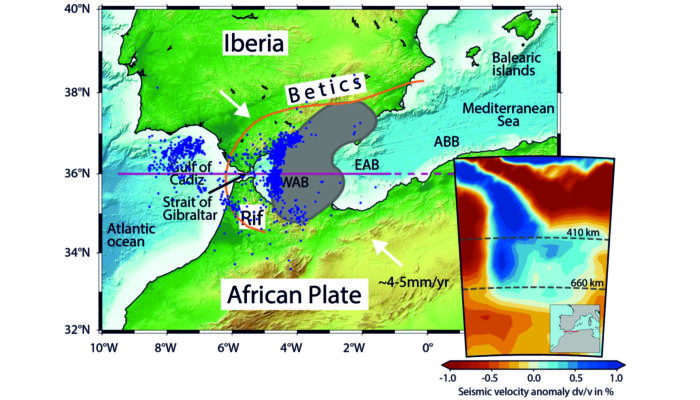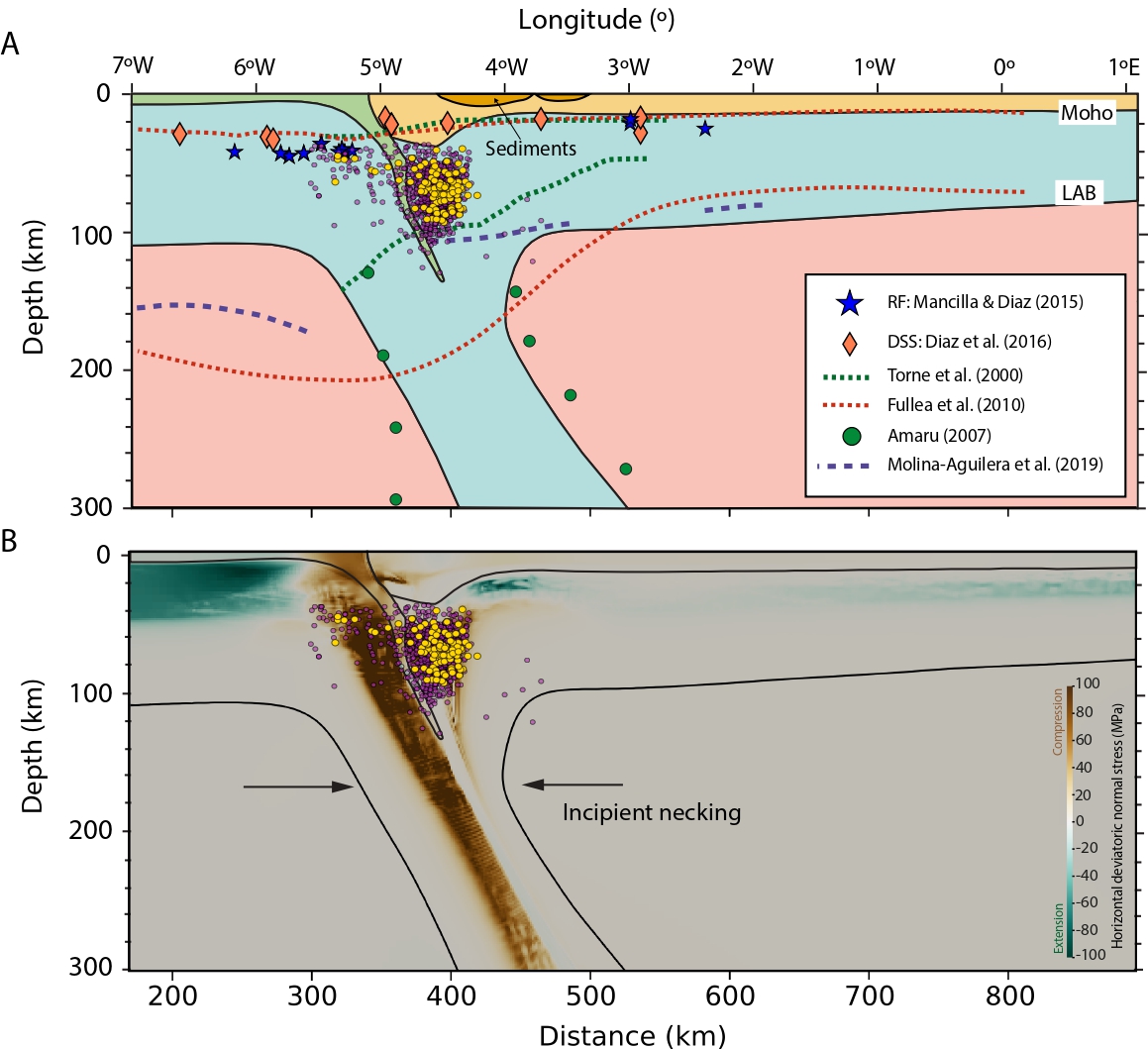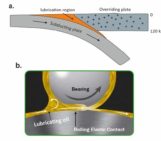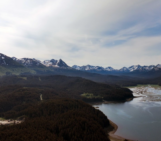
Figure 1. Topography of the Gibraltar Arc region. The shaded area indicates the position of positive seismic velocity anomaly supposedly representing the position of the slab at 270 km depth from seismic tomography (Amaru, 2007). The purple line shows the position of the modelled cross-section for the model shown in this blog. Blue dots indicate the regional intermediate seismicity (between 40 km and 150 km deep), from Instituto Andaluz de Geofisica Catalogue.
The origin and tectonic evolution of the Gibraltar Arc system are the result of a complex geodynamic evolution involving the convergence of the Eurasian and African plates and the dynamic impact of the subducted Gibraltar oceanic plate. Geological, geophysical as well as numerical geodynamic modelling studies have pointed out how the westward retreat of the subducting plate explains the geodynamics of the area. In our new study we have investigated the effect of the subduction dynamics on the deformation of the Alboran domain and its control on the origin of intermediate seismicity in this area. In this blog post, we will dive deeper into this matter!
What is the tectonics setting of the Gibraltar Arc?

Pedro J. Gea is a PhD student at the University of Granada working on subduction modeling. In this post, he shares the results of his latest study on the complex interplay between Gibraltar subduction dynamics and Alboran domain deformation.
The Gibraltar Arc system is located in the convergence zone of the Eurasian and African plates and forms part of the tectonic framework of the Western Mediterranean region (Figure 1). This area is characterised by a subducted oceanic plate known as the Gibraltar slab, which is located under the Gibraltar Arc, Betics and Rif Mountains and extending through the upper mantle (e.g., Spakman and Wortel, 2004). The region is also subject to seismicity of low-to-moderate magnitude, including mainly shallow earthquakes (less than 40 km deep), intermediate depth earthquakes (between 40 km and 150 km deep, Figure 1) which mostly occur within the subducted slab as well as rare deep seismic events at ~ 600-650 km depth.
Previous studies have run 3D numerical models (e.g., Chertova et al, 2014) to demonstrate that the complex tectonic evolution of the Gibraltar arc is associated with the westward migration of the slab toward the subducting plate, a process known as slab rollback. Tectonic reconstructions indicate two main stages of subduction. The first stage, spanning from 20 to 10 million years ago (Ma), is characterized by westward rollback of the Gibraltar slab which initiated at ~ 20 Ma. The second stage is marked the cessation of the slab rollback since ~10 Ma until the present.
In this blog, I present the results of our new work (Gea et al., 2023), which provides new insights into the impact of the slab evolution on past and present-day deformation of the Alboran domain, as well as on the distribution of the seismicity in the region.
How does our numerical Models reveal insights into geological processes and seismic activity?
In this work we have run 2D thermo-mechanical numerical models to simulate the different stages of the Gibraltar subduction and get insight into the stress regime that influences the deformation of the Alboran upper plate. We found that the period of slab rollback during the early and middle Miocene (~ 20 – 10 Ma) was characterised by widespread lithospheric extension, during which most of the present-day crustal and lithospheric structures were formed (Figure 2A). As slab rollback ceased at the late Miocene (~ 10-8 Ma), compressional stresses intensified near the trench while extension to the east of the overriding Alboran lithosphere remained active (Figure 2B). Only minor deformation associated with subduction is predicted during this time. Finally, our model successfully predicts a notable increase of interplate compressional stresses which is consistent with the present-day distribution of intermediate-depth earthquakes in western Alboran (Figure 2B). This finding supports the interpretation that this seismicity is likely related to the interplate compression processes.
Figure 2. (A) Model predictions for the present-day crustal structure and Lithosphere-Asthenosphere Boundary. The magenta dots are the location of the intermediate-depth seismicity along the profile from the Instituto Andaluz de Geofisica catalogue and the yellow dots are their relocations from Santos-Buenos et al. (2019). (B) Horizontal stresses with intermediate seismicity. Brown areas indicate compression and green areas indicate extension.
Could the Alboran domain deformation be driven by subduction-induced mantle flow?
Our models predict two well-differentiated stages of deformation of the Alboran lithosphere driven by slab-induced asthenospheric mantle flow (Figure 3). During the first stage (20 to 10 Ma), the westward trench retreat due to the rapid slab rollback induces mantle flow that applies basal traction beneath the overriding Alboran lithosphere. This basal traction increases towards the trench (Figure 3A), driving the above overriding plate to move trench-ward at a variety of rate. The difference of velocity increasing trench-ward in the overriding plate is responsible for distributing tensile deviatoric stress throughout the Alboran domain.
In the second stage (10 Ma to the present), the cessation of slab rollback results in a change in the style of the asthenospheric mantle flow beneath the Alboran domain, the steepening of the slab and the stagnation of the trench. Consequently, the overriding plate is dragged towards the trench at a faster rate than the trench retreats, creating a convergent velocity difference between them. The convergence between the trench and the overriding plate causes the compressional stresses in the subduction front (Figure 3B). At the same time, the width of the extensional zone in the overriding plate decreases.
To put these results into the bigger picture, the overall observed stress pattern has been attributed primarily to two sources. One is the ongoing NW-SE oblique convergence of the Eurasian and African plates, and the other is a secondary stress source which is likely related to the westward basal drag of the Alboran lithosphere and trench stagnation due to slab steepening. These results are in line with the models of Pons et al. (2022), which can explain the shortening pulses observed in Central Andes according to slab steepening cycles reducing trench retreat.
Figure 3. Simplified representation of the two stages of the Alboran lithospheric deformation. (A) Westward slab rollback during the early and middle Miocene (~ 20 Ma – 10 Ma). (B) Slab stagnation since late Miocene (~ 10-8 Ma).
Is the subduction system presently active?
Finally, the question of whether the Western Mediterranean subduction system is still active or not has been a subject of controversy for the last two decades. Gutscher et al. (2002) proposed an active subduction zone based on a marine seismic survey in the Strait of Gibraltar, but more recent works have indicated the inactivity of the subduction system (e.g., Stich et al., 2006; Santos-Bueno et al., 2019). For example, Stich et al. (2006) found a lack of significant relative motion between GPS stations located on both sides of the subduction front, suggesting that there is no signature of active subduction, while Santos-Bueno et al. (2019) computed the focal mechanisms for 42 earthquakes at depths from 50 to 100 km beneath the Gibraltar Arc without a relation with downdip stresses, further supporting that subduction is not presently active.
Our modelling results shed light on this ongoing debate about the current activity of the subduction system. The simulations show that although the subduction system may have slowed down or stopped at the surface, the slab is still moving deeper in the upper mantle. This deep movement of the slab generates an induced mantle flow that is still contributing to the present-day kinematics of the Alboran domain and the Gibraltar Arc region.
Bibliography
Amaru, M. (2007). Global travel time tomography with 3-D reference models. Ph.D. thesis. Utrecht, Netherlands: Utrecht University. Chertova, M., Spakman, W., Geenen, T., Berg, A., and van Hinsbergen, D. J. J. (2014). Underpinning tectonic reconstructions of the Western mediterranean region with dynamic slab evolution from 3-d numerical modeling: Western mediterranean slab evolution. J. Geophys. Res. Solid Earth 119, 5876–5902. doi:10.1002/2014JB011150 Diaz, J., Gallart, J., and Carbonell, R. (2016). Moho topography beneath the iberian-Western mediterranean region mapped from controlled-source and natural seismicity surveys. Tectonophysics 692, 74–85. doi:10.1016/j.tecto.2016.08.023 Fullea, J., Fernàndez, M., Afonso, J., Vergés, J., and Zeyen, H. (2010). The structure and evolution of the lithosphere–asthenosphere boundary beneath the atlantic–Mediterranean transition region. Lithos 120, 74–95. doi:10.1016/j.lithos.2010.03.003 Gea, P. J., Negredo, A. M., & Mancilla, F. d. L. (2023). The Gibraltar slab dynamics and its influence on past and present-day Alboran domain deformation: Insights from thermo-mechanical numerical modelling. Frontiers in Earth Science, 11. doi: 10.3389/feart.2023.995041 Gutscher, M. A., Dominguez, S., Westbrook, G., Le Roy, P., Rosas, F., Duarte, J., et al. (2012). The Gibraltar subduction: A decade of new geophysical data. Tectonophysics 574-575, 72–91. doi:10.1016/j.tecto.2012.08.038 Mancilla, F. d. L., and Diaz, J. (2015). High resolution moho topography map beneath iberia and northern Morocco from receiver function analysis. Tectonophysics 663, 203–211. doi:10.1016/j.tecto.2015.06.017 Molina-Aguilera, A., de Lis Mancilla, F., Morales, J., Stich, D., Yuan, X., and Heit, B. (2019). Connection between the Jurassic oceanic lithosphere of the Gulf of Cádiz and the Alboran slab imaged by Sp receiver functions. Geology 47, 227–230. doi:10.1130/G45654.1 Pons, M., Sobolev, S. V., Liu, S., and Neuharth, D. (2022). Hindered trench migration due to slab steepening controls the formation of the Central Andes. Journal of Geophysical Research: Solid Earth, 127, e2022JB025229. doi:10.1029/2022JB025229 Santos-Bueno, N., Fernández-García, C., Stich, D., Mancilla, F. d. L., Martín, R., Molina-Aguilera, A., et al. (2019). Focal mechanisms for subcrustal earthquakes beneath the Gibraltar arc. Geophys. Res. Lett. 46, 2534–2543. doi:10.1029/2018GL081587 Spakman, W., and Wortel, R. (2004). A tomographic view on western Mediterranean geodynamics. Berlin, Heidelberg: Springer Berlin Heidelberg, 31. doi:10.1007/978-3-642-18919-7_2 Stich, D., Serpelloni, E., Mancilla, F. d. L., and Morales, J. (2006). Kinematics of the iberia–maghreb plate contact from seismic moment tensors and gps observations. Tectonophysics 426, 295–317. doi:10.1016/j.tecto.2006.08.004 Torne, M., Fernàndez, M., Comas, M. C., and Soto, J. (2000). Lithospheric structure beneath the alboran basin: Results from 3d gravity modeling and tectonic relevance. J. Geophys. Res. 105, 3209–3228. doi:10.1029/1999jb900281






